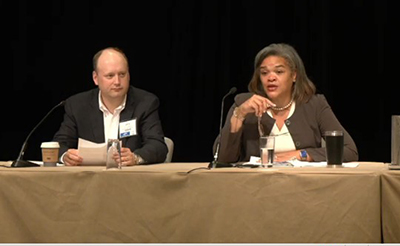
MISMO Fall Summit: Ginnie Mae Puts Foot on Gas Pedal

(MISMO President Seth Appleton and Ginnie Mae President Alanna McCargo address MISMO Fall Summit.)
WASHINGTON, D.C.—Ginnie Mae President Alanna McCargo will be the first to tell you that “speed” and “innovation” rarely appear in the same sentence with “federal agencies.” But she’d also be the first to tell you that it is possible.
“We’ve spent a lot of time since I joined Ginnie Mae talking about innovation and technology,” McCargo said Monday at the MISMO Fall Summit. “When you think of technology and the federal government, you think ‘slow.’ However, since 2010, we’ve been making huge strides.”
In the wake of the coronavirus pandemic, Ginnie Mae put a number of steps in place to provide relief. “We eased pooling requirements and took steps to increase liquidity so that our issuers could continue lending,” she said. “The pandemic was a great test for Ginnie Mae and it helped us learn to adapt and change better.”
Today, McCargo noted, “we’re in a whole different ballgame, and because of higher interest rates, we don’t see a very active refinance market. Our affordable options continue to get used, but we’re starting to see the slowdown.”
Since coming on board as Ginnie Mae President in December, McCargo said the agency has embraced technology innovation. “We understand the benefits of technology,” she said. “And we are grateful to you and to all the partners who have been working with us, particularly on the innovation front. This work is incredibly important for us.
Over the past year, Ginnie Mae has focused on delivering new tools and services to its customers. “We are moving to a cloud-based environment for all of our operations—all the innovation we want to do in the future is based on this,” she said. “We’ve had very good adoption of our new pooling capacity. Over the past year we have been involved in a eMorgage pilot program. This is an important step in our strategic plan in which we are committed to digitization. We want our partners to cut costs through digital technology, so they can pass those savings to our customers.”
Additionally, in June Ginnie Mae updated its eGuide to include the ability for issuers to perform eMods to Ginnie Mae Notes. “To date we’ve closed 42,000 eNotes with a value of $11 billion, and we’re seeing big growth in the digital collateral space going forward.”
Also recently, McCargo said Ginnie Mae has been improving its Environmental, Social and Governance (ESG) efforts.
“’Social’ is our nature,” McCargo said. “Ginnie Mae can be a leader in crafting and defining a social bond and providing our investors with greater transparency. We’re just getting started on that and hope to have more online by the end of the year. This asset class is not in the forefront, but it is an opportune time to give it more visibility, because our investors are looking for ways to quantify it.”
McCargo also noted green disclosures, particularly on multifamily programs, have given Ginnie Mae more of an opportunity to quantify how investors can demonstrate their commitment to green opportunities. “We anticipate more growth on the single-family side in green bonds,” she said.
The current economic environment poses unique challenges, McCargo said. “We’re in a post-pandemic world now, but we still have a lot of people trying to catch up, and rapidly changing housing dynamics,” she said. “Housing supply and housing affordability are top of mind right now, and they remain difficult for the typical government borrower. It’s very difficult for first-time home buyers—and we serve 80 percent of the first-time buyer market. We used to be able to say that this was a ‘California thing,’ but the problem is everywhere.”
Complicating matters, McCargo said, is that banks have retreated from the mortgage lending space. “That is unfortunate,” she said. “Over the past year we’ve seen a tremendous increase in the number of independent mortgage banks in our portfolio. We’d like to see a better balance in our investor pool.
McCargo said Ginnie Mae is uniquely positioned to advance homeownership. “Our team has been running a successful government-run corporation for 54 years, ever since we split from Fannie Mae,” she said. “We play a huge role in affordable housing, whether it is residential or commercial. “We promote access to credit throughout the country. It is explicit in our charter that we have a social mission. We are a social impact company. We look at the millions of borrowers we serve, and we’re very proud of that.
“We’re in this moment now, particularly on the investment side, that makes Ginnie Mae very attractive in the global investment arena. This makes us more valuable for our customers. As an engine that supports mortgage loans, Ginnie Mae’s role is vital and this transformation is vital.”
